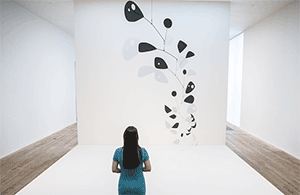Alexander Caldér
By Prof. Francesco Carelli, University Milan, Rome
 Cirque miniatures, sculptures floating, drawing in space, coming from the roof, made of music and movement, able to make reflect Albert Einstein
Cirque miniatures, sculptures floating, drawing in space, coming from the roof, made of music and movement, able to make reflect Albert Einstein
Widely celebrated as the originator of the ” mobile “, Alexander Caldér was one of the most innovative and influential American artists of the 20th century. An exhibition at Tate Modern in London focuses on Calder’s pioneering approach to sculpture, as he overturned many traditional assumptions about the medium.
At a time when sculptures were still usually made from stone, bronze or wood, Calder’s use of wire was seen as radically new. His approach seems especially striking because Calder’s was a sculpture of line rather than mass, defined by critics as ” drawing in space “. He felt that it was a mark of modernity that his wire figures possessed a kind of transparency, allowing other objects to be visible through them.
Calder first established his reputation through the performance that he staged with Cirque Calder, a complex, unique body of work which attracted a devoted following among the Paris avant-gard, such as Cocteau, Mondrian, Mirò. The miniatures were made using wire and a variety of unconventional materials such as fabric, cork and buttons and each figure was designed to execute individual circus acts
His explorations of sound and movement, of chance and intervention, and the ways in which an artwork can respond to or alter its surroundings, took place within a milieu informed by developments in music and choreography as much as by fine art. Embodying the vitality of dancers or acrobats, Calder’s sculptures were performers in their own right. Small Sphere and Heavy Sphere could be classified as sculpture, installation, musical instrument and performance. The red sphere is pushed so that the white sphere arbitrarily knocks against an arrangement of bottles, a box, a can, and a gong on the floor. Calder would allow viewers to organise and reorganise these objects as they wished ( for conservation reasons this is no longer possible ). They were chosen for the range of different sounds that they could produce, resulting in what Calder described as a series of ” thuds, crashes, etc “. The different weights of the spheres mean that the pattern of movement can’t be predicted, so that a unique aural composition is generated each time the work is set into action.
When Calder visited Mondrian’s atelier, it was the revelation about abstraction, describing the studio as ” the shock that converted me. It was like the baby being slapped to make its lungs start working “. So, he set about the challenge of combining abstraction and movement, creating works incorporate into a frame within which the elements of the sculpture are suspended from wires. As well as providing means of support, the frames act like the proscenium arch of a theatre, helping to focus the gaze of the viewer, suggesting two-dimensional abstract paintings that have taken kinetic three-dimensional form.
In addition to works with a free motion, Calder experimented with sculptures controlled by a small motor, effectively embodying the mechanical processes that were an implied subject in many cubist and futurist paintings. When these works were exhibited, critics were charmed by their handmade mechanical devices, but also drew attention to their performative qualities, describing their ” quasi-astral dance ” . However, the motorised elements were always at risk of breaking down, and they are now too fragile to be operated. He recognised that the ability to control movement was perhaps less fertile than the potentially infinite possibilities that opened up with free movement.
At the New York World’s Fair in 1939, Calder created models for three “ ballet-objects” each of which resembled a miniature stage upon which different elements would revolve to create a choreographed movement. In addition, he designed a spectacular “ ballett “ to be performed by the jets of water leaping into the air from the fourteen spouts of a fountain outside the Consolidates Edison building.
“The underlying sense of form in my work has been the system of the Universe “ , Calder wrote in 1951. “ The idea of detached bodies floating in space, of different sizes and densities…some at rest, while others move in peculiar manners, seems to me the ideal source of form “. When A Universe was first exhibited at the Museum of Modern Art, New York, Calder was told that Albert Einstein stood watching it for forty minutes, waiting for the mechanism to work through the ninety cycles of movement before it began to repeat itself.
Around the mid – 1930s Calder developed what has become the classic form of the mobile: an elegant network of wires and painted pieces of sheet metal, suspended from the ceiling. Rather than following a series of predetermined movements, these mobiles are continually changing. In a text from 1932, Calder envisaged works with “ each element able to move, to stir, to oscillate, to come and go in its relationships with other elements in its universe “. This delicate series of interrelations means that the work as a whole seems to sway with its own independent life.
In the 1940s Calder constructed a number of mobiles incorporating gongs of different pitches. Small hanging beaters would be put into motion at irregular intervals, producing of musical notes. His sculptures became a reference point for many experimental composers, particularly those pursuing ideas of “ open “ composition.
One of the more tangible legacies of Calder’s trip to South America was Black Widow, which was donated by the artist to the Institute of Architects of Brazil in Sao Paulo. Usually hanging in a central space in the institute’s headquarter, and loaned abroad for the first time for this exhibition, the 3.e meter sculpture demonstrates the ability of Calder’s work to define an architectural space rather than simply occupying it.

